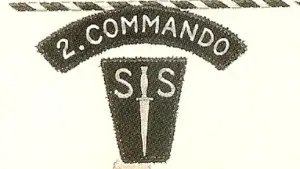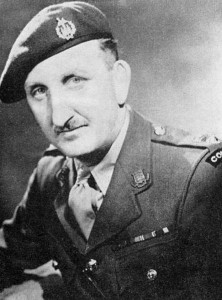 We can’t meet the Commando standards of 1940, can you? Some things, yes, and some things, no. Now, in the peak of youth, we could have done it. Here’s an extract from “Service in a Commando” by Lt. Col. AC Newman, who was OC of No. 2 Commando when he drafted this document.
We can’t meet the Commando standards of 1940, can you? Some things, yes, and some things, no. Now, in the peak of youth, we could have done it. Here’s an extract from “Service in a Commando” by Lt. Col. AC Newman, who was OC of No. 2 Commando when he drafted this document.
Before they get to the nuts and bolts of physical standards and training requirements, the Commandos want to know what sort of character a recruit has:
Irregular warfare demands the highest standards of initiative, mental alertness and physical fitness, together with the maximum skill at arms. No Commando can feel confident of success unless all ranks are capable of thinking for themselves; of thinking quickly and of acting independently, and with sound tactical sense, when faced by circumstances which may be entirely different to those which were anticipated.
And what sort of mind:
Mentally. The offensive spirit must be the outlook of all ranks of a Commando at all times.
Here’s the part where a middle-aged stout body with only one working ankle is going to have trouble:
Physically. The highest state of physical fitness must at all times be maintained. All ranks are trained to cover at great speed any type of ground for distances of five to seven miles in fighting order.Examples:
- Fighting Order (seven miles in one hour (march & run).
- F.S.M.O. (Full Service Marching Order) (15 miles in 4 hrs) ; 5 miles in one hour (marching) (25 miles in 8 hrs) ; 9 miles in two hours (marching) (35 miles in 14 hrs).
After all these distances and times, troops must be ready, in para (a) to fight, and in para (b) to fight after two hours rest.
Now, back in the day, we could’ve done that, and often did. But it’s a pretty high standard. (listing the 15-mile event first suggests it is of major importance. The usual SF endurance event is a 12-mile rucksack march over mixed dirt and paved roads, to a time which has historically varied from 2:30 to 3:30. It’s an ass-kicker, as 15 miles in WWII Tommy Atkins rig would be, also).
We’re assuming Fighting Order and FSMO are pretty close to our concepts of Combat Load and Sustaining Load. Our event was done with 45 to 65 lbs in the ruck, as the full SF sustaining load might well be over 100 lbs., which is inimical to rapid movement.
The interesting bit there is the complete absence of such PT requirements as form indirect measures of combat fitness. They don’t care how many pull-ups, push-ups, crunches you can do, or how fast you can run 1, 2, or 26 miles: you need to walk, and haul your kit, and be ready to rock on arrival. They don’t even care if you can swim, but you’d better be comfortable in boats regardless: “[T]he sea comes to be regarded as a natural working ground for a Commando.”
There’s also map reading and compass work, night evolutions, cliff climbing, and unarmed combat. Everybody will be able to use the radios; conduct urban combat; forage for his own food; treat gunshot wounds.
Interestingly enough, there’s no mention of marksmanship or skill with rifles, pistols, or other small arms. It may have been so understood as to have gone unsaid. Demolitions did get mentioned:
All ranks will have elementary knowledge of demolitions and sabotage. All ranks will be confident in the handling of all types of high explosives, Bangalore torpedoes, and be able to set up all types of booby traps.
And, as every viewer of commando movies knows, a Commando needs to be able to drive the Mercedes staff car, Hanomag halftrack, or steam engine he’s just carjacked from some unlucky German:
All ranks in a Commando should be able to drive motor cycles, cars, lorries, tracked vehicles, trains and motor boats.
Barely two things are missing that form part of the modern SF / SOF pipeline: parachuting, which in 1940 was a technological and combat elite of its own, and survival, evasion, resistance and escape training. Of course, they could have skipped the Resistance Training Lab part, as beginning in 1942, all Commandos captured were either shot on the spot, or transported to concentration camps for execution.
Newman himself just barely dodged that bullet, being captured after the famous St. Nazaire Raid (in which HMS Campbelltown acted as a seagoing time bomb, wrecking the only French drydock which could handle DKM Tirpitz). Newman was taken captive just before the Commando Order was published; he survived the war to receive his VC for St. Nazaire, and to serve in the SAS.
All in all it sounds like a hell of a place to hang out, exactly the kind that would attract just the right (and for the conventional army, the wrong) sort of fellows. But there were limits to the freedom, and Commando powers came with Commando responsibilities, enforced by a terrifying threat:
Any falling short of the standards of training and behaviour on the part of a Special Service Soldier will render him liable to be returned to his unit.
“Back to the Royal Welsh Cannonfodder with you, Taffy…” You can just see it happening. No doubt the threat alone kept most potential miscreants in the rank well in line.
The influence of the British Commandos of World War II on today’s American SF and SOF is not coincidental. Our World War II Ranger Battalions were formed and trained in the Commando mold, the earliest of them in the Commandos’ own training centers. The reason today’s Rangers wear unit scrolls, and introduced shoulder tabs into the US Military? That’s the influence of the cousins acrosss the pond. And late in the Korean war, the Ranger companies which had been expended as infantry in the face of Chinese human-wave attacks were disbanded, to free up the personnel slots for the new Special Forces organizations. Many of SF’s early founders had Ranger backgrounds, and transmitted Col. Newman’s Commando ethos into the new organization. When the Ranger battalions came back (originally as a scheme to cut and eliminate SF!) and other units stood up, the Commando ethos and a surprising number of Commando procedures continue to live on.
You could do worse than organize a unit today, selecting and training your personnel according to Newman’s 17 points.
Colonel Newman’s entire 17-point memo is available in .pdf at the Commando Veterans’ website. Enjoy.

Kevin was a former Special Forces weapons man (MOS 18B, before the 18 series, 11B with Skill Qualification Indicator of S). His focus was on weapons: their history, effects and employment. He started WeaponsMan.com in 2011 and operated it until he passed away in 2017. His work is being preserved here at the request of his family.


4 thoughts on “Can you meet the Commando standard?”
Thanks for posting this. I always enjoy reading the background and history of this sort.
What, really, could I add? I enjoyed the read.
Excellent. It’s always good to know the standards over time.
I wish I could comment on your excellent blog, but for technical reasons I can’t use the widget you use. Thanks for turning out for the Patterson memorial. I’m across the country; I’ll be attending that for Colonel Rheault this Saturday before beginning a road trip.